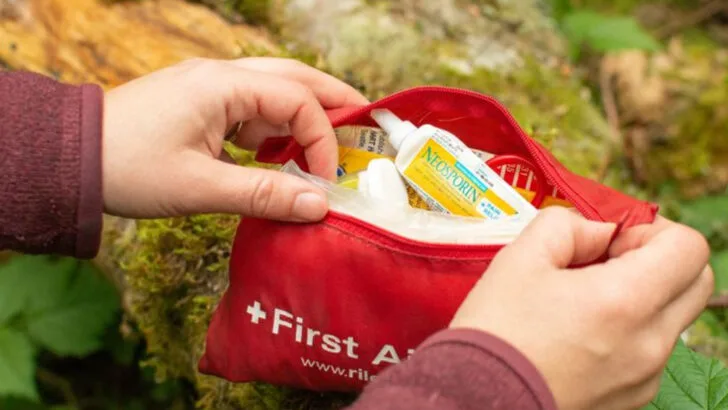Because even a short trail can turn into a long day if you’re unprepared.
There’s something magical about setting out on a trail with nothing but a pack and a purpose. Whether you’re tackling a forest loop, a mountain ridge, or a coastal bluff, day hikes offer quick access to big adventure—without the commitment of overnight gear. But just because the trail is short doesn’t mean it’s risk-free. Weather changes, twisted ankles, hunger pangs, or wrong turns can turn a peaceful outing into a stressful scramble if you don’t have the right gear in your pack.
The good news? You don’t need to spend a fortune or pack like you’re headed to Everest. With a few smart items and a little planning, you’ll stay safe, hydrated, and happy from trailhead to trail-end. Whether you’re hiking solo, with kids, or meeting friends, this list of 15 absolute must-haves will keep your day hike smooth, safe, and satisfying.
So before you lace up your boots and hit the path, double-check your pack for these hiking essentials. Your future self (and your feet) will thank you.
Water (More Than You Think You’ll Need)
Dehydration can strike unexpectedly, especially on warm days or high-altitude trails. Always bring more water than you think you’ll need; a general guideline is at least 1 liter for every 2 hours of hiking. This ensures you remain hydrated, energetic, and ready to tackle the trail’s challenges. Proper hydration not only fuels your body but also keeps your mind sharp as you navigate the path. Remember, streams and lakes are picturesque but not always safe for drinking; always carry purified water. Taking a break with a refreshing drink is a simple pleasure you shouldn’t be without.
High-Energy Snacks
Ever felt hangry on a hike? High-energy snacks are the remedy, offering quick bursts of energy to keep you moving. Think trail mix, packed with nuts and dried fruits, or energy bars that fit snugly in your pocket. These snacks are lightweight but rich in calories, making them perfect companions for your adventure. Each bite fuels your muscles and satisfies your taste buds, ensuring you stay motivated during the trek. Remember, sharing a snack break with fellow hikers is also a great way to bond over the shared love of nature and adventure.
A Map and Compass (or GPS App with Offline Maps)
In the age of smartphones, it’s easy to rely on digital maps, but technology can fail. Carrying a map and compass is a timeless navigation duo for any hiker. They don’t need charging or a signal and offer a tactile way to engage with your surroundings. A GPS app with offline maps is a modern alternative, providing the benefits of technology while planning ahead for areas with no reception. Whichever you choose, knowing how to use them is crucial. Having these tools ensures you’re prepared for unmarked trails and unexpected detours.
First Aid Kit
A first aid kit is like a trusty companion that steps in when things go awry. Small enough to fit in your backpack, it contains bandages, blister pads, antiseptic wipes, and ibuprofen. These essentials can mean the difference between continuing your hike or heading back to the trailhead early. Accidents happen, from minor cuts to unexpected blisters, and being prepared allows you to handle them with ease. Equip yourself with basic first aid knowledge, and you’ll hike with confidence, knowing you’re ready for the unexpected challenges nature may throw your way.
Sunscreen and Lip Balm with SPF
Even on shaded trails, UV rays can find you. Sunscreen and SPF lip balm are the unsung heroes of outdoor adventures, protecting your skin from harmful sun exposure. Apply them generously before setting out, and reapply as needed. Sunburn isn’t just a beachside concern; it’s equally relevant on a mountainous path where the sun’s rays are unyielding. Protecting your skin ensures a comfortable hike and avoids the discomfort of burns later. A simple act of applying sunscreen can keep your skin healthy and make your outdoor experience enjoyable and worry-free.
A Hat and Sunglasses
A hat and sunglasses are more than just style statements; they’re essential companions on a hike. They shield your eyes from the sun’s glare and your skin from UV exposure. A wide-brimmed hat offers shade, while sunglasses protect against eye strain. Together, they enhance your focus and comfort as you explore the trail. Beyond their practical uses, they add an air of confidence to your hiking ensemble. As you traverse open paths or forested trails, remember that these simple items guard you against the elements, allowing you to soak in the views without squinting.
Layers for Changing Weather
Mountain weather is famously fickle, and packing layers is your best defense. A sunny morning can quickly shift to a chilly afternoon, and being prepared keeps you comfortable. Lightweight fleece and rain jackets are ideal companions, easily fitting into your backpack. They provide warmth and protection against unexpected showers, ensuring you remain dry and cozy. As the sun sets, layers offer the versatility needed to adapt to cooling temperatures. Dressing in layers isn’t just practical; it’s a strategic way to enjoy your hike without worrying about the whims of Mother Nature.
Headlamp or Flashlight
Imagine the sun setting quicker than anticipated, leaving you in the dim light of dusk. A headlamp or flashlight is an invaluable tool, illuminating the path ahead and keeping you safe. Unlike phone flashlights, these lights are designed for prolonged use and rugged trails. Lightweight and easy to carry, they ensure you never lose your way, even when daylight fades unexpectedly. A reliable headlamp not only guides your steps but also adds a layer of security in unfamiliar terrain. When hiking, light is a companion you shouldn’t overlook.
Multi-Tool or Knife
A multi-tool is the Swiss Army knife of the hiking world, compact yet brimming with utility. Whether fixing gear, preparing food, or addressing minor emergencies, its versatility is unmatched. From cutting rope to opening food packages, this tool handles it all. Lightweight and easy to carry, it fits seamlessly into your hiking kit. It’s not just a tool; it’s a problem solver that adapts to various needs on the trail. Having one means you’re ready for the surprises that nature might throw your way, adding a layer of preparedness to your adventure.
Bug Spray or Repellent Wipes
Buzzing mosquitoes and lurking ticks can quickly turn a hike into a battle. Bug spray or repellent wipes are your defense against these persistent pests. A small bottle or pack of wipes fits easily in your bag, ready to be deployed when needed. Applying repellent not only ensures comfort but also protects against bites and potential diseases. It’s a simple step that can significantly enhance your outdoor experience. Don’t let insects dictate your hike; take control with these protective measures and enjoy the natural world free from unwanted distractions.
Lightweight Sit Pad or Towel
Pause and rest during your hike with a lightweight sit pad or towel. These simple items add comfort to breaks, allowing you to relax on damp logs or rocky terrain. Compact and easy to carry, they provide a dry, cushioned spot to enjoy the view or snack. The beauty of nature is best appreciated when you’re comfortable, and a sit pad enhances that experience. As you take a moment to breathe, the soft support beneath you becomes a reminder that sometimes the simplest comforts are the most rewarding.
Plastic Bag for Trash
Leave no trace is a guiding principle for outdoor enthusiasts, and a plastic bag for trash is essential. It’s a simple tool for maintaining the trail’s beauty, collecting wrappers, cores, and any remnants of your journey. Clipped to your backpack, it serves as a constant reminder to respect the environment. This habit ensures that the natural landscape remains pristine for future hikers to enjoy. It symbolizes a commitment to conservation, demonstrating that every little bit counts in preserving the wilderness we cherish. Carrying a trash bag is a small act with a significant impact.
Trekking Poles (Optional but Useful)
For those who seek stability and support, trekking poles are invaluable. They distribute weight, reducing strain on knees and aiding balance on uneven terrain. Though optional, they become essential on longer hikes, proving their worth when tackling steep ascents or descents. Lightweight and adjustable, they fit various terrains and hiking styles. Whether you’re crossing streams or navigating rocky paths, these poles enhance your rhythm and endurance. They’re more than just poles; they’re an extension of your hiking experience, offering support and confidence as you explore the wilderness.
Trail Etiquette and Common Sense
Not all essentials are tangible; trail etiquette and common sense are just as crucial. Yield to uphill hikers, maintain a moderate noise level, and always inform someone of your plans. These unwritten rules ensure a harmonious experience for everyone. Respect the trail and fellow adventurers by being considerate and aware. Hiking isn’t just about the destination; it’s about the journey and the connections you make along the way. By practicing good etiquette and common sense, you contribute to a positive outdoor culture, fostering a sense of community among hikers.

